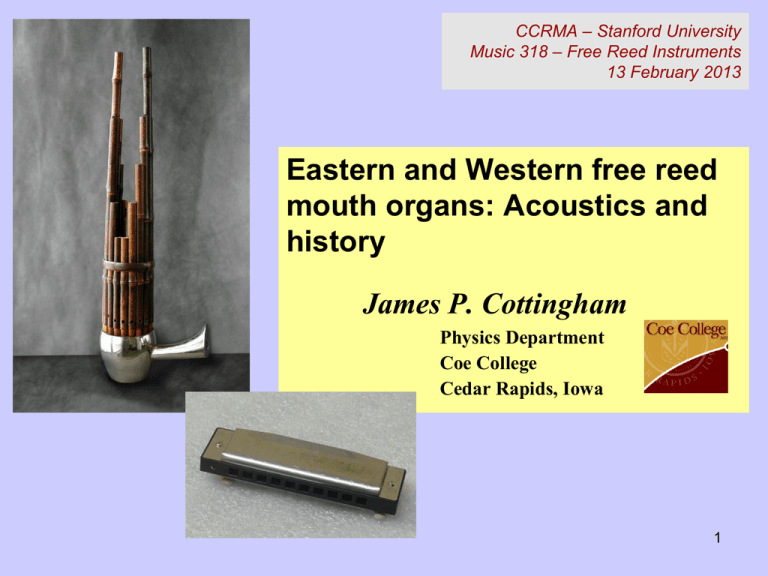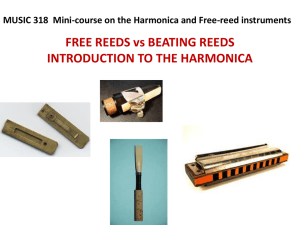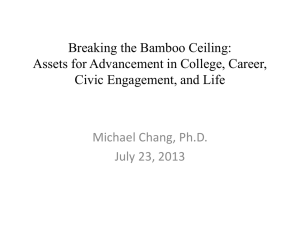Cottingham-1 - CCRMA
advertisement

CCRMA – Stanford University Music 318 – Free Reed Instruments 13 February 2013 Eastern and Western free reed mouth organs: Acoustics and history James P. Cottingham Physics Department Coe College Cedar Rapids, Iowa 1 Property of Thomas Rossing 2 The free reed instruments --• I. The Asian free reed mouth organs (today) – khaen, naw – sheng, sho – bawu, hulusi • II. Western free reed instruments (2nd session) – harmonica – reed organ and harmonium – accordion/concertina family • III. Pitch Bending (2nd session) – harmonica – ree reeds with pipes – accordion 3 I. The Asian free reed mouth organs --A. Overview of Eastern and Western free reed instruments with some examples B. Some ancient Asian instruments C. The khaen: construction and acoustics 4 A. Asian Mouth Organs Pipes 5 Western Mouth Organs No Pipes 6 ACKNOWLEDGMENTS • Pat Missin (www.patmissin.com) for use of photos and sound clips. The sound examples are played by Pat Missin. • Terry E. Miller, Profesor Emeritus, Kent State University, for providing expert advice and opinion on the Asian free reed mouth organs, as well as video of khaen making • Lydia Ayers, Composer and former Visiting Professor, Hong Kong University of Science & Technology for 3 animated slides of Chinese free reed mouth organs • Financial support from: • The National Science Foundation REU Grant No. PHY1004860 • The Coe College Acoustics Research fund 7 The free reed instruments --two main families The Asian free reed mouth organs use flat, symmetric free reeds like the reed from a sheng (left) The Western free reed instruments, first developed around 1800, use “offset” reeds like the one from an American reed organ (right) 8 P1 P2 • Cross-sectional view of a free reed used in Western free reed instruments. • The solid line represents the position of the reed at rest. • The dashed lines show approximate maximum excursions for the blown vibrating reed. • This reed will normally only sound for a pressure difference P1 > P2. • The thickness of the reed plate (grey) varies from instrument to instrument. • In some cases the reed tip may never pass below the reed plate. 9 Free reeds in Asian mouth organs •The elastic tongue vibrates through the frame •The reeds are symmetric: the vibrating tongue is cut from the frame •Reeds can be chiseled form a strip of metal… • or cut from cane or bamboo… •The same note can sound on both pressure (exhaling) and vacuum (inhaling) •These symmetric free reeds must be coupled to a resonator Asian free reed instruments - History • The Asian free reed instruments are undoubtedly of ancient origin • Most evolved as folk instruments with little or no historical documentation • Major exceptions to this are the instruments used in the courts of China and Japan • The sheng is mentioned in Chinese sources of the 11-12th century BC • The Shih-Ching reports the sheng used by ordinary people before the time of Confucius • Confucius (551-479 BC) is believed to have played the sheng. 11 The Asian mouth organs: Free reed coupled to pipe Symmetric reeds Often operate on both directions of airflow Reeds normally function as a “blown open” reed The sounding frequency is above both the natural frequency of the reed and the resonance frequency of the pipe 12 Typical Asian free reed mouth organs 1. Single free reed pipe with finger holes: 2. Multiple pipe instruments: gourd pipe khaen hulusheng naw 13 Complete khaen demonstrated (lai soi) Free-reed pipes with finger holes • Reed is placed at the closed end of a bamboo tube TM Closed end – plugged reed bawu • Tone quality varies with number of finger holes covered • A variation: gourd pipe with finger holes 15 • The bawu has a metal free reed which produces a sound similar to the clarinet. 16 Free-reed pipes with finger holes • Reed is placed at the closed end of a bamboo tube • Tone quality varies with number of finger holes covered bawu - all tone holes closed bawu - 4 of 8 tone holes closed 17 Frequency of a bawu as a function of pipe resonance frequency. Solid elliptical data points from underblowing are near the reed frequency (horizontal line). 18 Sound example on the free reed pipe ala (Vietnam) Pat Missin • One pipe similar to a bawu and one drone pipe with the reeds in a gourd wind chamber • A free reed mouth organ usually played by closing several pipes at a time • The reeds are in the closed ends of the pipes in a wind chamber. 21 B. Some ancient free reed instruments from Southeast Asia • Some of the very simplest free reed wind instruments: A typical multipipe free reed mouth organ (hulusheng, naw, …) naw (hulusheng) naw pipe 1.5 f1 = 433 Hz Open Naw Pipe 1.5 Impedance f1 = 354 Hz mouth-resonated lamellophones (“jew’s harps”) • common throughout Southeast Asia • sides of the vibrating tongue cut from a single piece of wood, bamboo, or metal • Tongue is not be plucked directly, but is excited by plucking the frame • played by placing the reed tongue over the lips of the player and using the vocal tract as a resonator. • Some traditional uses: – signaling – disguising the voice – imitation of natural sounds (such as frog calls) dan moi (Vietnam) huntoong plucked blown enggung (Bali) •constructed from a single piece of bamboo •designed as a wind instrument: •a single reed to be blown •the player can vary the pitch by changing the shape of the vocal tract (pitch bending) enggung … can be used (among other things) to imitate frog calls enggung The free-reed horn • Water buffalo or ox horn hollowed out and fitted with free reed: • Wax used to seal the reed (and possibly for tuning) • Player can blow or suck to produce one of three notes: 1. Both ends open 2. Narrow end closed with hand 3. Both ends closed www.cambodianlivingarts.org The free-reed horn The free-reed horn C: Construction and operation of the Southeast Asian free reed mouth organ: khaen C. Outline • The khaen: – Design and Construction – Acoustical properties – The khaen – an ethnographic instrument • Video clips of khaen making - Terry Miller (1988) The khaen • 16 (or 6, 14, 18) free-reed bamboo pipes • Reeds of copper-silver alloy located at L/4 for each pipe • All reeds contained in a carved hardwood windchest • Reed section sealed in windchest by a black insect product, kishut • Tuning slots set effective pipe length to determine pitch • Finger holes burned in each pipe control tone production • Player activates reed by blowing or inhaling while covering appropriate finger holes 36 The khaen is the signature instrument of the Lao people of Northeastern Thailand and Laos Tuning slots Reed The khaen reed 19th century Thai coinage metal has been “traditionally” used to make the reeds. [Above: Thailand 2 att (1882)] reed Khaen reed mounted pipe Sounding frequency as a function of reed length (composite for 3 khaen) Reeds are typically made in two sizes. Pipe length is used to tune each reed-pipe to desired pitch. 39 Khaen Pipe Impedance Curve Khaen Pipe 4-10 Calculated Impedance Tuning slots reed Reed is located near L/4 Variation of sounding frequency with pipe length for a khaen pipe The reed-pipe sounds slightly above the pipe resonance frequency The khaen as ethnographic instrument • Detail of martial dancers and mouth organ players from a Vietnamese bronze gong [from the Garland Encyclopedia of Music] The khaen as a symbol of the Lao people of Northeast Thailand • Unlike many Asian traditional instruments, the khaen has not undergone any modernization • Despite dramatic changes in rural Thai society in the last 50 years, khaen making has not changed • The good ones are still made by village craftsmen • The khaen’s symbolic meaning has also changed little • A khaen (unamplified) now often appears with an ensemble including electric guitars and drums, identifying the music as “Northeastern.” Making a khaen reed Strip of metal is thinned by pounding reed tongue Three free sides of reed tongue are created using a small chisel. It is traditional to use the elephant bone. SEM image of portion of khaen reed. The scratches parallel to the reed tongue are from the bamboo honing blade Video excerpts: Khaen making in a village in Roi Et province, Northeastern Thailand Filmed in 1988 by Terry Miller Khaen making • • • • • Carving the wind chamber Beating kishut Shaping kishut into strips Assembling khaen Finishing touches Carving the wind chamber Beating kishut Shaping kishut into strips Assembling khaen Finishing touches Complete khaen demonstrated (lai soi) 53 Special session, Acoustical Society of America, San Diego 2011 Acoustics of Mouth Organs Followed by CONCERT CONCERT Mouth Organs East and West Khaen: Christopher Adler University of San Diego Music Department Harmonica: Howard Levy 5:00-6:00 p.m. Monday, October 18 Garden Salon 54











